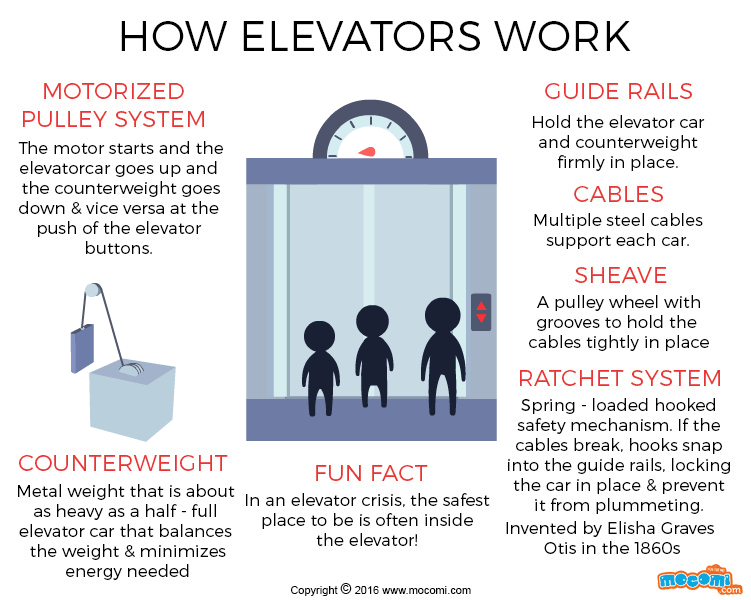With the push of a button, you summon a metal box that saves you from trudging up flights of stairs. In fact, for any building more than 4 floors high, an elevator is practically a must. Can you even imagine skyscrapers being around if not for elevators? And apart from the ease and convenience to most people, elevators also make life easier for those with physical handicaps. Elevators are an innovation we’re so used to, that few of us ever pause to wonder how this box works.
Elevator Pulley System
Have you ever tried drawing water out of a well? If so, you’ve used a pulley. The bucket is attached to a rope which passes through a wheel, making it easier to draw water out. The earliest elevators worked on the same principle. They were manually operated, and were powered by laborers / animals. Of course, the modern elevator uses much more elaborate and sophisticated mechanisms to better handle the weight of the elevator and its cargo but the principle is essentially the same.
Working Principle of Elevator
An elevator is basically a metal box attached to a very strong metal rope. This rope goes through a “sheave” in the engine room above the elevator. A “sheave” is the equivalent of a pulley wheel. It has grooves to hold the rope tightly. The entire system is motorized. When you push the call button (or the floor button), you activate the motor and the elevator goes up, down or stops. The key parts of an elevator are –
1. The metal car that we ride in
The car of the elevator is a metal box that is held in place by guide rails and supported by strong metal cables. There are two sets of doors in an elevator door, and most modern elevators are locked using an automated system. Unless they are forced open, the outer doors open only when an elevator car is on the floor. This is to prevent people from accidentally falling into the shaft from a moving elevator.
2. The counterweight
On the other end of the metal cable is a metal weight, about as heavy as the elevator would be when it is half full. This is to balance the weight of the elevator car, thereby minimizing energy needed to operate it.
3. The cables
As mentioned, the elevator car is supported by multiple cables of very strong metallic rope twisted together. They’re strong enough that even if one of them snaps, the elevator doesn’t fall to its doom. But what if all the cables break? Well, elevators aren’t just suspended in midair on metallic ropes. They’re also held in place by guide rails on the sides of the elevator. And there’s also a ratchet system for added safety. This safety system was invented by Elisha Graves Otis back in the 1860s. Each car ran between two vertical guide rails with sturdy metal teeth embedded all the way up them. At the top of each car, there was a spring-loaded mechanism with hooks attached. If the cable broke, the hooks sprung outward and jammed into the metal teeth in the guide rails, locking the car safely in position.
4. The electric motor and the braking system
At the push of the button, the motor is activated. When the motor turns one way, the sheave raises the elevator; when the motor turns the other way, the sheave lowers the elevator. The sheave, the motor and the control system are all housed in a machine room above the elevator shaft.
5. Safety systems
Apart from the above mentioned ratchet safety system, there are also speed governors (to control the speed of the elevator) and hydraulic or gas spring buffers to minimize impact damage in the event of a malfunction.
Fun Fact: In times of elevator crisis, the safest place to be is often right inside the elevator!


